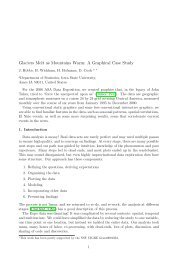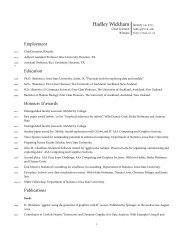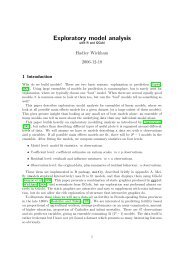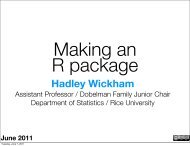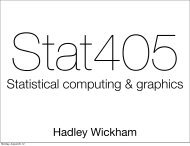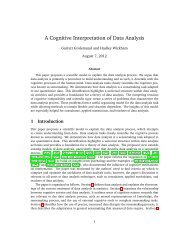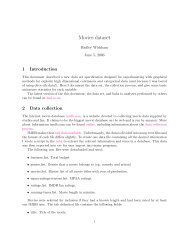You also want an ePaper? Increase the reach of your titles
YUMPU automatically turns print PDFs into web optimized ePapers that Google loves.
July 2010<br />
Friday, 9 July 2010<br />
<strong>Introduction</strong> <strong>to</strong> <strong>plyr</strong><br />
<strong>Hadley</strong> <strong>Wickham</strong><br />
Assistant Professor / Dobelman Family Junior Chair<br />
Department of Statistics / Rice University
Friday, 9 July 2010<br />
1. US baby names data<br />
2. Slice & dice revision<br />
3. Group-wise operation<br />
4. Challenges<br />
5. More <strong>plyr</strong> functions, including an<br />
example of llply and ldply
Friday, 9 July 2010<br />
Baby names<br />
Top 1000 male and female baby<br />
names in the US, from 1880 <strong>to</strong><br />
2008.<br />
258,000 records (1000 * 2 * 129)<br />
But only four variables: year,<br />
name, sex and prop.<br />
CC BY http://www.flickr.com/pho<strong>to</strong>s/the_light_show/2586781132
Friday, 9 July 2010<br />
Getting started<br />
library(<strong>plyr</strong>)<br />
library(stringr)<br />
options(stringsAsFac<strong>to</strong>rs = FALSE)<br />
bnames
head(bnames, 15)<br />
year name percent sex<br />
1 1880 John 0.081541 boy<br />
2 1880 William 0.080511 boy<br />
3 1880 James 0.050057 boy<br />
4 1880 Charles 0.045167 boy<br />
5 1880 George 0.043292 boy<br />
6 1880 Frank 0.027380 boy<br />
7 1880 Joseph 0.022229 boy<br />
8 1880 Thomas 0.021401 boy<br />
9 1880 Henry 0.020641 boy<br />
10 1880 Robert 0.020404 boy<br />
11 1880 Edward 0.019965 boy<br />
12 1880 Harry 0.018175 boy<br />
13 1880 Walter 0.014822 boy<br />
14 1880 Arthur 0.013504 boy<br />
15 1880 Fred 0.013251 boy<br />
Friday, 9 July 2010<br />
> tail(bnames, 15)<br />
year name percent sex<br />
257986 2008 Neveah 0.000130 girl<br />
257987 2008 Amaris 0.000129 girl<br />
257988 2008 Hadassah 0.000129 girl<br />
257989 2008 Dania 0.000129 girl<br />
257990 2008 Hailie 0.000129 girl<br />
257991 2008 Jamiya 0.000129 girl<br />
257992 2008 Kathy 0.000129 girl<br />
257993 2008 Laylah 0.000129 girl<br />
257994 2008 Riya 0.000129 girl<br />
257995 2008 Diya 0.000128 girl<br />
257996 2008 Carleigh 0.000128 girl<br />
257997 2008 Iyana 0.000128 girl<br />
257998 2008 Kenley 0.000127 girl<br />
257999 2008 Sloane 0.000127 girl<br />
258000 2008 Elianna 0.000127 girl
Friday, 9 July 2010<br />
Slicing<br />
and dicing
Friday, 9 July 2010<br />
subset(df, subset)<br />
Revision<br />
transform(df, var1 = expr1, ...)<br />
summarise(df, var1 = expr1, ...)<br />
arrange(df, var1, ...)
Friday, 9 July 2010<br />
Your turn<br />
Extract your name from the dataset. Plot<br />
the trend over time.<br />
What geom should you use? Do you<br />
need any extra aesthetics?
hadley
Friday, 9 July 2010<br />
Brains<strong>to</strong>rm<br />
Thinking about the data, what are some<br />
of the trends that you might want <strong>to</strong><br />
explore? What additional variables would<br />
you need <strong>to</strong> create? What other data<br />
sources might you want <strong>to</strong> use?<br />
Pair up and brains<strong>to</strong>rm for 2 minutes.
Friday, 9 July 2010<br />
Some of my ideas<br />
• First/last letter<br />
• Length<br />
• Number/percent<br />
of vowels<br />
• Biblical names?<br />
• Hurricanes?<br />
• Rank<br />
• Ecdf (how many<br />
babies have a<br />
name in the <strong>to</strong>p<br />
2, 3, 5, 100 etc)
letter
names
Friday, 9 July 2010<br />
Create a new variable that contains the<br />
first three (or four, or five) letters of each<br />
name. How many names start the same<br />
as yours? Plot the trend over time.<br />
Remember <strong>to</strong> use the group aesthetic if<br />
necessary.<br />
Your turn
names$first3
Friday, 9 July 2010<br />
Per-group<br />
operations
Friday, 9 July 2010<br />
What about group-wise transformations<br />
or summaries? e.g. what if we want <strong>to</strong><br />
compute the rank of a name within a sex<br />
and year?<br />
Group-wise<br />
This task is easy if we have a single year<br />
& sex, but hard otherwise.
Friday, 9 July 2010<br />
What about group-wise transformations<br />
or summaries? e.g. what if we want <strong>to</strong><br />
compute the rank of a name within a sex<br />
and year?<br />
Group-wise<br />
This task is easy if we have a single year<br />
& sex, but hard otherwise.<br />
Take two minutes <strong>to</strong> sketch out an approach
one
# Split<br />
pieces
x y<br />
a 2<br />
a 4<br />
b 0<br />
b 5<br />
c 5<br />
c 10<br />
Friday, 9 July 2010
x y<br />
a 2<br />
a 4<br />
b 0<br />
b 5<br />
c 5<br />
c 10<br />
Friday, 9 July 2010<br />
Split<br />
x y<br />
a 2<br />
a 4<br />
x y<br />
b 0<br />
b 5<br />
x y<br />
c 5<br />
c 10
x y<br />
a 2<br />
a 4<br />
b 0<br />
b 5<br />
c 5<br />
c 10<br />
Friday, 9 July 2010<br />
Split<br />
x y<br />
a 2<br />
a 4<br />
x y<br />
b 0<br />
b 5<br />
x y<br />
c 5<br />
c 10<br />
Apply<br />
3<br />
2.5<br />
7.5
x y<br />
a 2<br />
a 4<br />
b 0<br />
b 5<br />
c 5<br />
c 10<br />
Friday, 9 July 2010<br />
Split<br />
x y<br />
a 2<br />
a 4<br />
x y<br />
b 0<br />
b 5<br />
x y<br />
c 5<br />
c 10<br />
Apply<br />
3<br />
2.5<br />
7.5<br />
Combine<br />
x y<br />
a 2<br />
b 2.5<br />
c 7.5
# Or equivalently<br />
bnames
# Or equivalently<br />
bnames
Friday, 9 July 2010<br />
In a similar way, we can use ddply() for<br />
group-wise summaries.<br />
There are many base R functions for<br />
special cases. When available, they can<br />
be much faster, but you have <strong>to</strong> know<br />
they exist, and have <strong>to</strong> remember how <strong>to</strong><br />
use them.<br />
Summaries
Friday, 9 July 2010<br />
ddply + transform =<br />
group-wise transformation<br />
ddply + summary =<br />
per-group summaries<br />
ddply + subset =<br />
per-group subsets
Friday, 9 July 2010<br />
Challenges
Friday, 9 July 2010<br />
Warmups<br />
Which names were most popular in 1999?<br />
Work out the average usage for each<br />
name.<br />
List the all time <strong>to</strong>p 10 names.
# Which names were most popular in 1999?<br />
subset(bnames, year == 1999 & rank == 1)<br />
subset(bnames, year == 1999 & prop == max(prop))<br />
# Average usage<br />
overall
Friday, 9 July 2010<br />
Challenge 1<br />
For each name, find the year in which it<br />
was most popular, and the rank in that<br />
year. (Hint: you might find which.max<br />
useful).<br />
Print all names that have been the most<br />
popular name at least once.
most_pop
Friday, 9 July 2010<br />
Challenge 2<br />
What name has been in the <strong>to</strong>p 10 most<br />
often?<br />
(Hint: you'll have <strong>to</strong> do this in three steps.<br />
Think about what they are before starting)
<strong>to</strong>p10
Friday, 9 July 2010<br />
More <strong>plyr</strong><br />
functions
Friday, 9 July 2010<br />
Many problems involve splitting up a large<br />
data structure, operating on each piece<br />
and joining the results back <strong>to</strong>gether:<br />
split-apply-combine
Friday, 9 July 2010<br />
How you split up depends on the type of<br />
input: arrays, data frames, lists<br />
How you combine depends on the type of<br />
output: arrays, data frames, lists,<br />
nothing
array<br />
data frame<br />
list<br />
n replicates<br />
function<br />
arguments<br />
Friday, 9 July 2010<br />
array data frame list nothing<br />
aaply adply alply a_ply<br />
daply ddply dlply d_ply<br />
laply ldply llply l_ply<br />
raply rdply rlply r_ply<br />
maply mdply mlply m_ply
array<br />
data frame<br />
list<br />
n replicates<br />
function<br />
arguments<br />
Friday, 9 July 2010<br />
array data frame list nothing<br />
apply adply alply a_ply<br />
daply aggregate by d_ply<br />
sapply ldply lapply l_ply<br />
replicate rdply replicate r_ply<br />
mapply mdply mapply m_ply
Friday, 9 July 2010<br />
Case study
Friday, 9 July 2010<br />
Each country has its own GSHS spss file.<br />
How can we easily combine them all<br />
<strong>to</strong>gether?<br />
GSHS<br />
Run the following R code and try and<br />
figure out what each line does.<br />
Look at 04-gshs.r for answers.
library(foreign)<br />
library(<strong>plyr</strong>)<br />
library(stringr)<br />
files
Friday, 9 July 2010<br />
Resources
Friday, 9 July 2010<br />
Resources<br />
http://had.co.nz/<strong>plyr</strong>/<strong>plyr</strong>-<br />
intro-090510.pdf<br />
http://groups.google.com/group/<br />
manipulatr/
Friday, 9 July 2010
This work is licensed under the Creative<br />
Commons Attribution-Noncommercial 3.0 United<br />
States License. To view a copy of this license,<br />
visit http://creativecommons.org/licenses/by-nc/<br />
3.0/us/ or send a letter <strong>to</strong> Creative Commons,<br />
171 Second Street, Suite 300, San Francisco,<br />
California, 94105, USA.<br />
Friday, 9 July 2010




